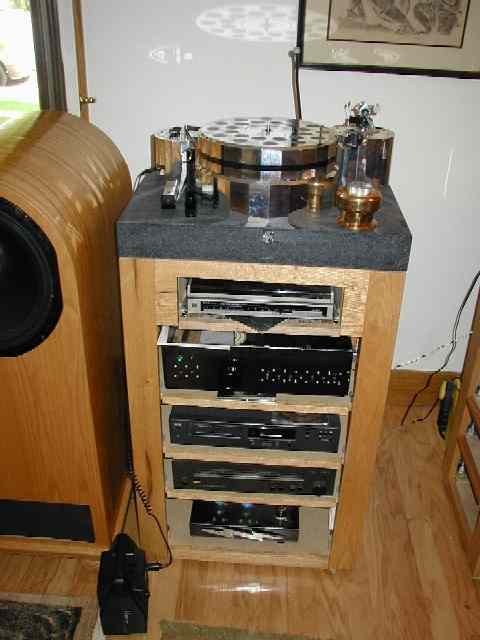
Cactus Tube Dudes of Arizona
Rev. Clark invited us over to his abode to listen to my Beta Se~ duc~ tion (bottom right corner) with vinyl played on his Redpoint turntables.Get together.
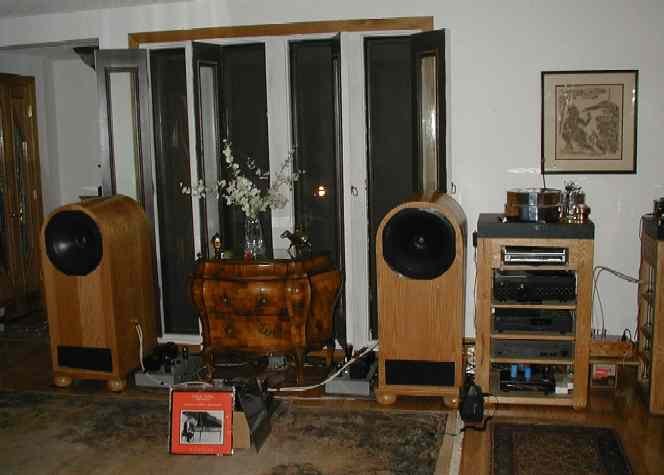
Now this is an
audio rack. Don't even think about stubbing your toe on it.

This is his new
turn table design. It is kind of fun to watch it spin.
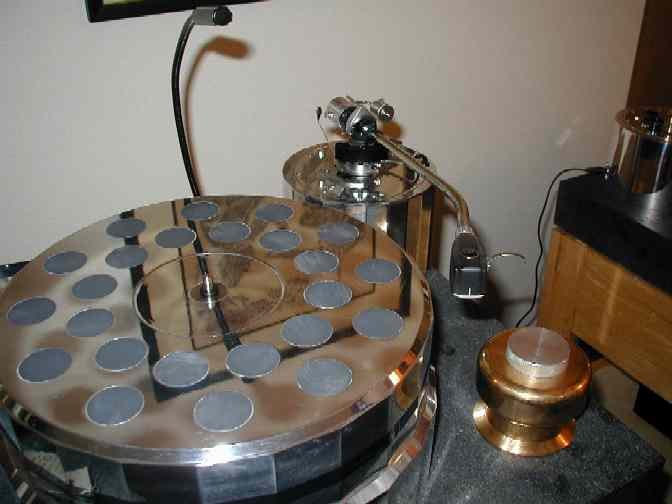
Now a side view.
It is shinier than what the pictures show. Think show room Harley shiny.
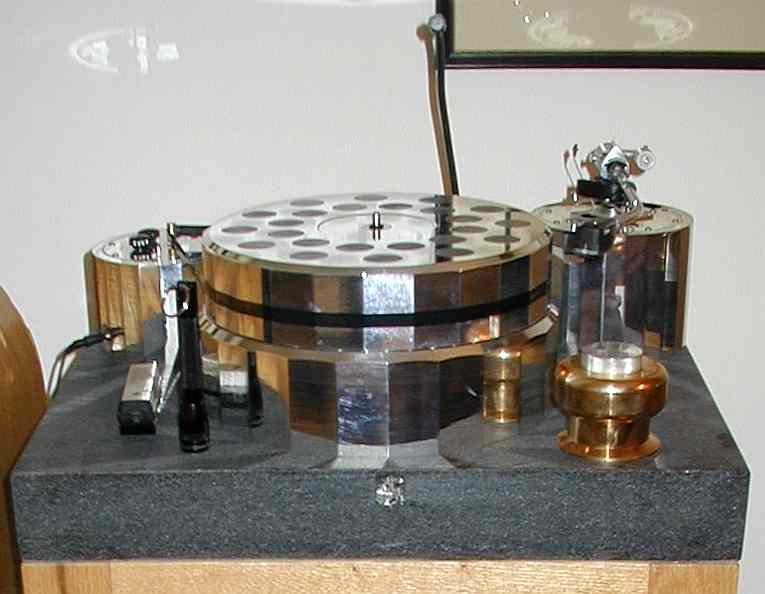
This is the
turntable that drove the Se~ duc~ tion.

With a stand like Rev Clark's, you have to have two of them! The Se~ duc~ tion below is dwarfed by the stands. The 3/4 inch all tread goes from the granite down to the floor. The step up transformer is the first box below the turntable.
The shelves are
moved by loosening the nuts and spinning them up or down to where you
want the shelf to be. Peter, if you ever decide to sell stand kits, let
me know!
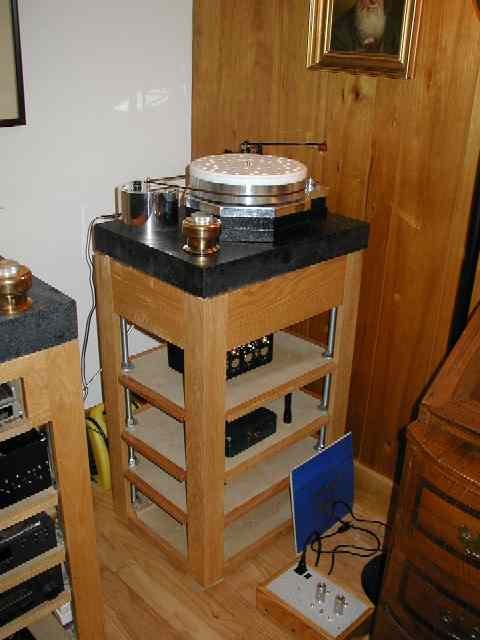
Here's Peters 45
amp. Plenty loud with his 100 dB/W speakers.
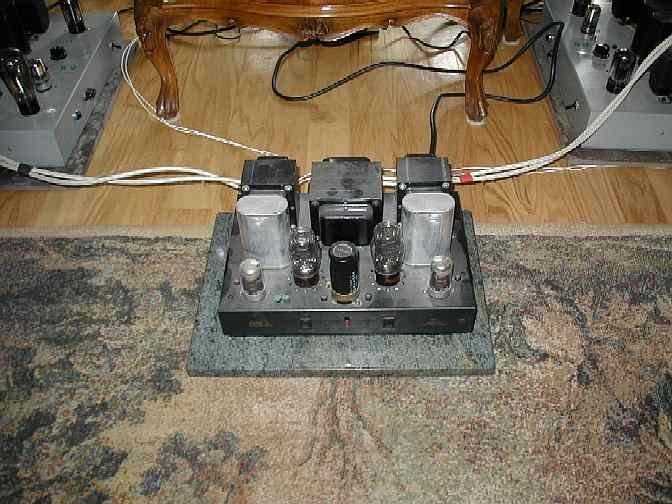
Here is some of
the left over toys. Peter had a stack of experimental platters on the
floor too. I didn't get a picture of them. But the $ invested is his
rejects dwarfs having silver speaker cables! I'll bet his "research
dogs" sound better than most people turntables. Too bad they're door
stops now.
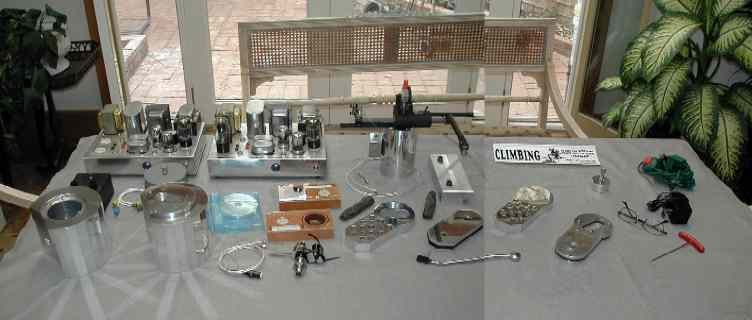
We listened to Peter's home made phono preamp for a while. The tonal presentation on his phono preamp was a bit flatter and his amp was a bit quieter in the low frequencies than the almost stock Se~ duc~ tion. The high frequency noise was about the same. The stock and modified Se~ duc~ tion had a bit of high frequency edge that upon looking at the tubes I had, Peter said it was the brand of tubes.
The "almost" part of "almost stock" is that I added a power indicator bulb, moved the transformer 1/2 inch off the bottom plate (per Doc Bottlehead's suggestion) and used an improved HV snubber (my design.)
The first listen caused me a bit of a panic and elevated heart rate. We got all bass and everything else was muted. So I'm checking ohms and volts for 1/2 an hour. Nothing was wrong. I finally took a guess and asked how it got hooked up. I guessed right. Peter's helper plugged the Se~ duc~ tion output into the input of Peter's existing Phono stage. Two RIAA stages in a row sound like one of those boom cars that go down the highway: Too much bass and no highs.
At this point, many people had to leave for other commitments and missed out on the rest of the fun.
After we figured the bass problem out. We got to listen to it. It was musical, but very noisy with a lot of hum. I started feeling equipment cases and cables to see if any of them made a change. The step up transformer's case was sensitive. So we grounded the case of step up transformer to the Se~ duc~ tion and the hum went away. With the added ground, it was now quiet and sounded pretty good. Peter's custom 3 X 12SN7 phono preamp was better, but he's been tweaking it for years.
After a few LPs, I added the Hawksford version of an active load I've been playing with. This active load behaves like a 20K ohm resistor at DC and like a CCS above 10 Hz. This design has never been attached to a tube before. It had been powered by a lab supply at half rated current to verify the solder joints, but had only powered a tube in a computer model. My heart rate was up (both installing a mod and first power up of a circuit in front of a crowd.) The Se~ duc~ tion's clarity was a lot better with the active load, but we had a some intermittent burst noise at this point. The new noise sounded like RF or dimmer noise. The noise had some modulation to it.
My active load cards hung down almost even with the bottom of the wood box. The Se~ duc~ tion was on the tile floor. On a whim I held it about a foot over the floor and the noise dropped considerably, but was still there. We found a cardboard box to put under the Se~ duc~ tion so we could listen long term. This was really good sounding, better than before. I didn't really care about the bit of noise left. At this point it was difficult for me to listen to others talk because the music was so involving (sorry if I appeared to be rude and not listen to those of you talking to me.)
More info (after the party) :
I brought my Se~ duc~ tion home. At that point I thought a good portion of my noise is just transformer pick up. I gave the modified Se~ duc~ tion a quick listen back at home and it sounds like transformer buzz, not RF oscillations. RF oscillations tend to be whistle like or "dimmer" like. Transformer buss will sound different depending on what noise is on the power line. The noise was louder in the right channel than in the left. The right channel is closest to the power transformer.
I finally took a 20 MHz scope to active load (my 465 is down until it gets repaired.). I was fooled, the active load does oscillate when driving the Se~ duc~ tion. I didn't see the oscillation when it was powered by 44V DC (all I can get from my lab supplies.) The oscillation was being amplitude modulated by the transformer noise. That is why I thought it was transformer buzz. I tried a few bypass ceramics on the aluminums in the active load and dropped the oscillation level, but it still oscillated. I could still wave my hand over it and change the frequency. (That got a few funny looks from the better half: me frowning at the scope and waving my hands over a circuit mumbling weird words. . .like I could cast a spell and make it all better!. . .Solder, Solder, Find and damp that hidden coil. . .)
I haven't had a circuit oscillate on me in years (at least one that wasn't supposed to). I was actually enjoying this. (Yes I'm off the deep end.) I played around a bit longer and found that the base of the output MJE350 was moving in step with the oscillation. I put a 732 ohm grid stop resistor in the base of the MJE350 and the oscillation stopped dead. (732 ohm was magic because that was the current set resistor and I had a bag of about 50 of them in front of me.) I could wave at the boards and nothing changed.
Now the Se~ duc~ tion was kicking serious butt. Still a little bright, but I still had young tubes that the Rev wasn't fond of. Those of you with Se~ duc~ tions and a bit of walking around cash, seriously think C4Ss or active loads at 4 mA.
Just a tidbit, I
like this filament snubber. Short leads and the parts are as far from
the grids as possible while still providing a good RF bypass:
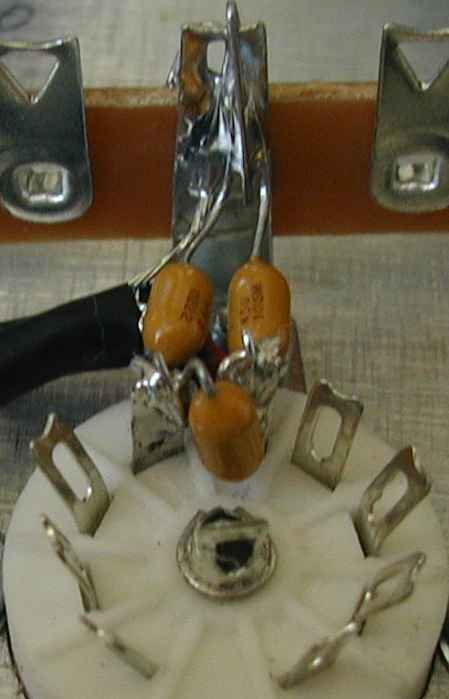
Food: Diet Pepsi, Sprite, burgers, crinkle chips, potato salad and coleslaw.
Amps:
Peter's capacitor-coupled single ended 45 stereo amp.Speakers:
15 inch Fanes (15DX HE 8 ohm ) with TAD2001 Compression drivers (8 ohm) for the coaxial tweeters. The cabinets are from AIT International.Preamps:
Peter's custom preamp (a single 14AF7 tube)CD Player:
Peter's custom phono amp (12SL7 based)
Voltsecond's Beta Se~ duc~ tion (non-stock HV snubber/ Power indicator and later the oscillating active load.)
You've got to be kidding!Low level Interconnects:
Peter's custom silver interconnectsSpeaker Interconnects:
Peter's custom silver interconnects (Yes, Silver going to the speaker. I believe this is "fine silver" not "sterling" nor 213 nines silver.)Turntable:
Redpoint Testa Rossa XS with SME 3012-R arm and Ortofon SPU GM Classic played on Peter's phono amp only. The step up trannies are Newcomb TR91s. The record weight is The Anvil by Redpoint.Some of the Vinyl Played:Redpoint Quattro SE with Moerch DP-6 Arm and Benz MO9. Step up was a Stevens & Billington TX-103 from Bent Audio. (Used to drive the Se~ duc~ tion).
The phono interconnects were 28 ga. coaxial cable with SMA connectors.
Nora
Jones
Come Away With Me
Holly Cole
Temptation
David
Byrne
Music for knee play
David Grisman
Hot Dawg
Mary Margaret OHara Miss America
Blood
This
Mortal Coil
Dead can Dance
Toward the Within
Tony
Rice
Native
American
The Tony Rice Unit Mar West
Leslie
Tung
Forte Piano (Mozart Hayden Beethoven) Wildboar Records.
Various
Deadicated
(sic) Arista Records. (Susan Vega's track played.)
Attendees:
Peter C.About Se~ duc~ tion: Yes I wimped out. I don't want the "unrelated" search engines linking to my site so I added the "~ ". I figured the search engines would pick up a "-" and the "~ " looked classier than an "*".
Volt S.
Royce M.
Boyd B.
Al M.
Bob ?
Todd K.
Tom M.
Richard R.
John ?
Jeromie S.
Alan K.
Toby C.
Footnote:
I've been asked how I implemented Doc's idea of moving the transformer
off of the chassis by 1/2 inch or a bit more.
I used a longer screw than stock and added more nuts and star washers.
The stack up I used went as follows:
Screw (new) <-- wish I had used a longer screw.
Bushing (stock)
Ground plane (stock)
Bushing (stock)
Star washer (New)
Nut (New)
1/2 inch Space (measure the threads)
Nut (New)
Star washer (New) <-- not in picture, but I wish I would have installed it.
Transformer (stock)
Star washer (New)
Ground lug (stock)
Nut (new)
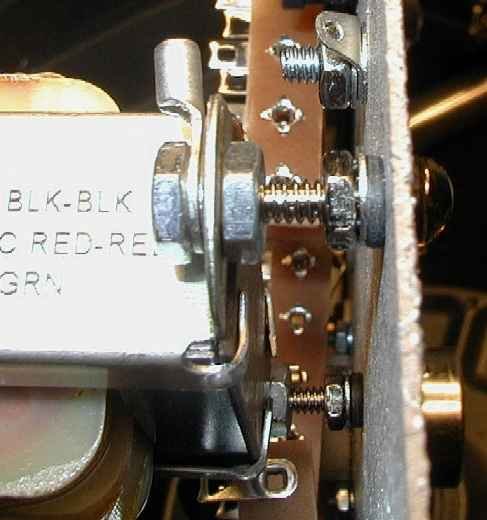
 ( New
2024 index page.)
( New
2024 index page.)
 _( Old 2003 index page.)
_( Old 2003 index page.)
 _( AMP Second index
page.)
_( AMP Second index
page.)
 ( Fancy index page.)
( Fancy index page.)